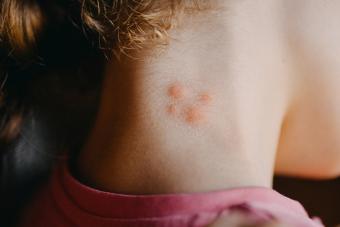
Dry skin in winter cracks and bleeds if your skin is prone to drying out and does not receive the proper care. Prevent this painful condition by caring for skin regularly with good, nourishing lotions with healing ingredients.
Why Dry Skin in Winter Cracks and Bleeds
Chapped hands and feet in winter are a result of the reduction of needed water in the skin. The top layers of your skin normally retain a regular amount of water. With constant exposure to drying conditions, the water decreases and makes the skin less supple and easier to crack. Small fissures occur in the dry skin and as the fissures split and deepen the skin bleeds. Small areas of cracked skin may appear at first then spread as the conditions worsens. People of all ages may display this condition but if most often occurs with people who have chronic dry skin.
Symptoms of Dry Winter Skin
Since dry winter skin is accompanied by discomfort or pain, it is simple to diagnose. However, a list of symptoms may help you recognize the onset of this condition. Winter skin problems manifest most often on the face, hands and feet but these itchy, painful problems are not exclusive to these areas. Look for these symptoms if you suspect your skin may be cracking.
- Roughness: Rough, bumpy skin is a symptom of dry cracking skin. You may feel raised bumps on the surface of your skin or feel grooves along natural creases.
- Dryness: Scaly-looking or flaking skin is a sign of dry winter skin. Dryness may persist even after you apply lotion or creams to your skin.
- Redness: Before skin cracks and bleeds, it will appear pink or red. Redness may even take on a purplish look right before the dry skin in cracks and bleeds.
- Sensitivity: Red patches may become sensitive to the lightest touch. Wearing clothing or doing the smallest task will become uncomfortable for people with dry cracking skin.
Causes of Dry Skin in Winter
Knowing the reasons behind this ugly, painful condition will arm you for battle against Old Man Winter. Know some of the causes of drying, cracking skin so you can prevent it from worsening or spreading to other parts of your body.
- Exposure to cold weather: Cold winter winds and temperatures make winter skin worse. Wear protective clothing to shield your skin from frigid temperatures that dry out your epidermis.
- Hot water: Hot showers and baths dry out your skin's natural oils. Natural oils keep the skin lubricated and slow down painful cracking. Avoid taking hot showers or baths during winter.
- Skin disorders: Eczema and psoriasis sufferers have it worse in winter. These skin disorders weaken the skin's ability to retain moisture.
- Heating units: Heating units give us warm temperatures indoors but they can also have a drying effect on skin. Use a humidifier regularly to restore moisture to the air in your home.
- Frequent hand washing: Washing your hands frequently will make sensitive hands feel rough. Avoid using antibacterial gels and stay away from hot water when cleaning your hands.
If your skin cracks and bleeds, you should visit your physician or dermatologist for a topical prescription. Over the counter topical medications may give you some relief too.
Therapeutic Moisturizers
Hand and body lotions will give the top layers of skin some relief but for healing help you need therapeutic moisturizers. Therapeutic moisturizers create a barrier between the skin and the elements while healing the skin on a deeper level. Try a therapeutic moisturizer containing one or more of these ingredients. Winter skin care should include a deep therapeutic moisturizer.
- Vitamin D
- Vitamin E
- Aloe
- Shea butter
- Lavender
- Chamomile
Dry skin in winter cracks and bleeds if you do not protect it. If you are prone to dry skin in winter take precautions before an onset of cracking occurs. If your hands do begin to bleed, use topical ointments to return the suppleness and elasticity of your skin and give you pain relief.







